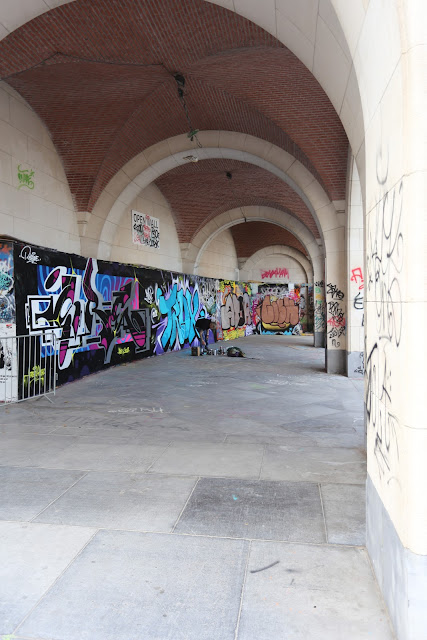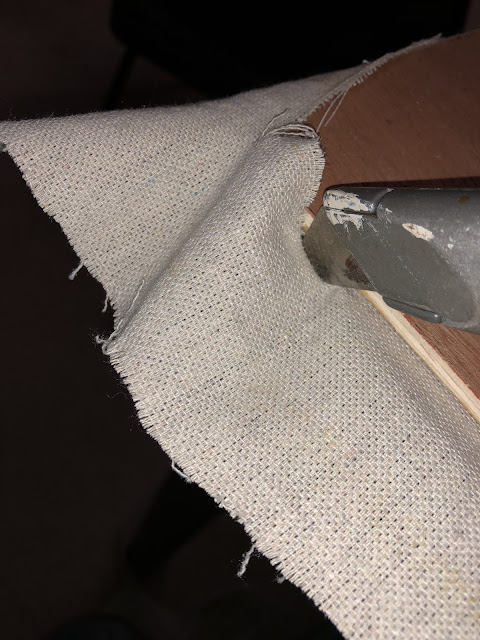How could I make the subject matter interesting and cute, and most of all, auspicious. My selfish motivation was to have a representational painting to welcome the Year of the Pig, which will happen in about 2 months' time.
Again I was faced with the choice of style for my rendition, whether to paint the pigs Gongbi or Xieyi style. I just couldn't shake the shackle despite my understanding that this was so unnecessary.
My sketches were obviously line drawings, so I thought I would attempt the Gongbi style, but I knew my calligraphy was very weak and I was afraid to reveal my weaknesses. The narcissist in me was urging me not to do it. It was really cumbersome. Before I could even wet the Xuan I was having trepidations already. I was very conscious of the fact that since I identified myself as a brush artist, then I had better show my expertise in the brush. I suppose Chinese brush has so much nuances about the brush tip, the flow and Qi that it has become very intimidating.
I had an opportunity to admire Vincent Van Gogh's works in their original forms and I came away with the impression that his lines showed none of the virtues I looked for in Chinese brush. His tree branches, outlines of buildings and objects were what I would call wet noodles, totally devoid of the Qi that I was look for; and yet his works are so valued and admired. Other than his bold, short brush stroke patterns, the quality of his brush was pretty monotonous. Obviously this is purely my own impression.
Take his famous Sunflower painting for example
one could sense a huge difference in where the emphasis was. Both were representational art, but immensely different in their impressionistic appearance and feel. The Chinese painting was all about brush strokes and ink tones. It displayed the intimate relationship amongst the brush, paper and ink.
Let us take a look at a landscape painting Wheatfield With Crows by Van Gogh,
and compare that with a Chinese landscape painting by Chao Shao-An, a master of Ling-nan School painting
the intricate brush strokes of Chao was in stark contrast with the bold dabs from Van Gogh.
I remember an occasion when a fellow student told my teacher that she was going to paint a Chinese painting in Van Gogh style. I didn't exactly know what she meant by it or how she was going to do it but my teacher was incensed. He actually asked that student to not take lessons from him again.
The teacher was irate because he demanded the practice of Ji Ben Gong, the craft of the fundamentals. Every brush stroke must encompass the calligraphic virtues by showing the tip used, flow and Qi. His ire was more than a manifestation of tribalism.
Van Gogh was interested in Japanese paintings and he tried his hands in a few. He painted this Courtesan
and here's a painting of a Dunhuang character from a Chinese painter, Zhang Daqian
again we saw how succinctly different were the way the lines were written.
I was hoping to present the notion that this is not a matter of which is better, or more valid.
How do you compare a Pinot noir to Huangjiu, or Moutai to Vodka. Before we venture to compare these different alcoholic beverages, we do however need to know what they are and what makes a good Vodka or Moutai. One would not try to find the hint of tannin from huangjiu. A vodka bottled in a Chinese vessel does not make a moutai. But regardless of whether they are brewed with grapes or millet, when these fermented or distilled liquid reaches certain levels of excellence, they shall all be appreciated and consumed.
Having said that, allow me to be the devil's advocate. Allow me to pose a question. Van Gogh's love for Asian art notwithstanding, could his Courtesan painting pass for Asian art? If we found that painting in an attic with no signature to reveal the painter, what would our appraisal be? Would that be an Asian painting done in Van Gogh style? Or a western painting trying to emulate the Asian flavor. What is Chop Suey? Is that Chinese food? When I see westerners put soy sauce in their tea I wonder if they were being naive, or was it their preconception that soy sauce goes with everything? Could it be that they were just thinking outside of the box and was on an intrepid journey to explore tastes? You might be surprised to learn that there is a soy sauce flavored ice cream!
I suppose the art of painting is not a monolith of just brushstrokes, or color or composition or style. It is an amalgamation of all the techniques, but most importantly, emotion. A great painting must have a soul. A great painting must have a personality, one which moves us.
Soul is defined as an emotional or intellectual energy or intensity, especially as revealed in a work of art or an artistic performance. The essence or embodiment of a specific quality; that je ne sais quoi.
Thus where I might deem Van Gogh as not possessing the calligraphic brush strokes, nonetheless his works effervesces in other ways and tugs at me just the same. The standards and parameters are simply different. A dog does not have plumage and a bird has no fur. His works possessed a soul.
I suppose all I was doing was trying to convince myself again, repeatedly, to let go of my inhibitions and preconceived hurdles. I should be worried about the soul and not the shell.
So I just painted whatever came to my mind, and not worry about the style
Incidentally van Gogh is pronouced differently in Amsterdam than from the States. So should I insist, during the course of my conversation, that people here pronounce van Gogh the way Dutch do, as a gesture of reverence and risk coming off as a pompous orifice between the gluteus maximus ?
Oink Oink Oink

















































